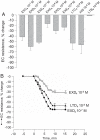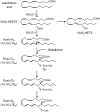Eoxins are proinflammatory arachidonic acid metabolites produced via the 15-lipoxygenase-1 pathway in human eosinophils and mast cells
- PMID: 18184802
- PMCID: PMC2206596
- DOI: 10.1073/pnas.0710127105
Eoxins are proinflammatory arachidonic acid metabolites produced via the 15-lipoxygenase-1 pathway in human eosinophils and mast cells
Abstract
Human eosinophils contain abundant amounts of 15-lipoxygenase (LO)-1. The biological role of 15-LO-1 in humans, however, is unclear. Incubation of eosinophils with arachidonic acid led to formation of a product with a UV absorbance maximum at 282 nm and shorter retention time than leukotriene (LT)C4 in reverse-phase HPLC. Analysis with positive-ion electrospray tandem MS identified this eosinophil metabolite as 14,15-LTC4. This metabolite could be metabolized to 14,15-LTD4 and 14,15-LTE4 in eosinophils. Because eosinophils are such an abundant source of these metabolites and to avoid confusion with 5-LO-derived LTs, we suggest the names eoxin (EX)C4, -D4, and -E4 instead of 14,15-LTC4, -D4, and -E4, respectively. Cord blood-derived mast cells and surgically removed nasal polyps from allergic subjects also produced EXC4. Incubation of eosinophils with arachidonic acid favored the production of EXC4, whereas challenge with calcium ionophore led to exclusive formation of LTC4. Eosinophils produced EXC4 after challenge with the proinflammatory agents LTC4, prostaglandin D2, and IL-5, demonstrating that EXC4 can be synthesized from the endogenous pool of arachidonic acid. EXs induced increased permeability of endothelial cell monolayer in vitro, indicating that EXs can modulate and enhance vascular permeability, a hallmark of inflammation. In this model system, EXs were 100 times more potent than histamine and almost as potent as LTC4 and LTD4. Taken together, this article describes the formation of proinflammatory EXs, in particular in human eosinophils but also in human mast cells and nasal polyps.
Conflict of interest statement
Conflict of interest statement: S.F., Å.B., L.B., C.E., and H.-E.C. are employed by Biolipox AB, a pharmaceutical company.
Figures





Similar articles
-
The influence of aspirin on release of eoxin C4, leukotriene C4 and 15-HETE, in eosinophilic granulocytes isolated from patients with asthma.Int Arch Allergy Immunol. 2013;162(2):135-42. doi: 10.1159/000351422. Epub 2013 Jul 31. Int Arch Allergy Immunol. 2013. PMID: 23921438
-
Roles of cysteinyl leukotrienes and their receptors in immune cell-related functions.Adv Immunol. 2019;142:65-84. doi: 10.1016/bs.ai.2019.04.002. Epub 2019 May 14. Adv Immunol. 2019. PMID: 31296303 Review.
-
Cysteinyl leukotrienes induce IL-4 release from cord blood-derived human eosinophils.J Allergy Clin Immunol. 2002 Jun;109(6):975-9. doi: 10.1067/mai.2002.124269. J Allergy Clin Immunol. 2002. PMID: 12063527
-
Arachidonic acid metabolism in the human mast cell line HMC-1: 5-lipoxygenase gene expression and biosynthesis of thromboxane.Biochim Biophys Acta. 1995 Jun 27;1257(1):58-74. doi: 10.1016/0005-2760(95)00048-h. Biochim Biophys Acta. 1995. PMID: 7599181
-
[Leukotrienes: potential therapeutic targets in cardiovascular diseases].Bull Acad Natl Med. 2006 Oct;190(7):1511-8; discussion 1518-21. Bull Acad Natl Med. 2006. PMID: 17450683 Review. French.
Cited by
-
Identification of Metabolites and Metabolic Pathways Related to Treatment with Bufei Yishen Formula in a Rat COPD Model Using HPLC Q-TOF/MS.Evid Based Complement Alternat Med. 2015;2015:956750. doi: 10.1155/2015/956750. Epub 2015 Jun 15. Evid Based Complement Alternat Med. 2015. PMID: 26170891 Free PMC article.
-
Update on recent advances in the management of aspirin exacerbated respiratory disease.Yonsei Med J. 2009 Dec 31;50(6):744-50. doi: 10.3349/ymj.2009.50.6.744. Epub 2009 Dec 18. Yonsei Med J. 2009. PMID: 20046412 Free PMC article. Review.
-
Loss of 15-lipoxygenase disrupts Treg differentiation altering their pro-resolving functions.Cell Death Differ. 2021 Nov;28(11):3140-3160. doi: 10.1038/s41418-021-00807-x. Epub 2021 May 27. Cell Death Differ. 2021. PMID: 34040168 Free PMC article.
-
Urinary lipid production profile in canine patients with splenic mass.J Vet Med Sci. 2022 Nov 1;84(11):1480-1484. doi: 10.1292/jvms.22-0355. Epub 2022 Sep 6. J Vet Med Sci. 2022. PMID: 36070921 Free PMC article.
-
Identification of PCSK9-like human gene knockouts using metabolomics, proteomics, and whole-genome sequencing in a consanguineous population.Cell Genom. 2022 Nov 15;3(1):100218. doi: 10.1016/j.xgen.2022.100218. eCollection 2023 Jan 11. Cell Genom. 2022. PMID: 36777185 Free PMC article.
References
-
- Claesson HE, Dahlen SE. J Intern Med. 1999;245:205–227. - PubMed
-
- Kuhn H, Walther M, Kuban RJ. Prostaglandins Other Lipid Mediat. 2002;68–69:263–290. - PubMed
-
- Kuhn H, O'Donnell VB. Prog Lipid Res. 2006;45:334–356. - PubMed
-
- Gulliksson M, Brunnström Å, Johannesson M, Backman L, Nilsson G, Harvima IT, Dahlén B, Kumlin M, Claesson H-E. Biochem Biophys Acta. 2007;1771:1156–1165. - PubMed
Publication types
MeSH terms
Substances
Grants and funding
LinkOut - more resources
Full Text Sources
Other Literature Sources
Molecular Biology Databases
Miscellaneous

